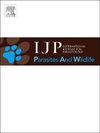梅花鹿(Cervus nippon)中的一种血管丝虫:日本 Elaeophora(线虫纲:盘尾丝虫科)的形态学和分子鉴定
IF 2.2
3区 医学
Q3 ECOLOGY
International Journal for Parasitology-Parasites and Wildlife
Pub Date : 2025-04-02
DOI:10.1016/j.ijppaw.2025.101068
引用次数: 0
摘要
盘尾丝状线虫(线虫纲:盘尾丝状线虫科)是一种感染反刍动物和马血管的丝状线虫,由tabanid蝇传播。2009年曾在日本和歌山县的野生梅花鹿中发现Elaeophora elaphi;然而,关于这个物种的详细信息是稀缺的。2023年,在日本奈良、Mie、京都和岐阜县的8只鹿的肝脏血管中采集了26条Elaeophora蠕虫并进行了分析。通过形态和遗传分析进行物种鉴定。此外,对7个基因进行了多基因分析,确定了它们在盘尾虫科中的分类位置。根据标本的形态特征,鉴定为elaphi。18S rRNA和细胞色素c氧化酶亚基1基因分析未发现变异,表明物种属于同一谱系。多基因分析表明,该物种属于盘尾丝虫亚科,与蜱传的Monanema属、Acanthocheilonema属、Litomosoides属、Cruorifilaria属、Yatesia属和Cercopithifilaria属亲缘关系密切。本研究证明了大尾尾鳗在日本的广泛分布,并为其与其他盘尾尾类物种的遗传关系提供了新的见解。需要进一步研究以确定该寄生虫的生态学和流行病学意义。本文章由计算机程序翻译,如有差异,请以英文原文为准。

A vascular filarial nematode in sika deer (Cervus nippon): Morphological and molecular characterization of Elaeophora (Nematoda: Onchocercidae) in Japan
Elaeophora (Nematoda: Onchocercidae), a filarial nematode infecting the blood vessels of ruminants and horses, is transmitted by tabanid flies. Elaeophora elaphi was previously detected in wild sika deer in Wakayama Prefecture, Japan in 2009; however, detailed information on this species is scarce. In 2023, 26 Elaeophora worms were collected from the hepatic vasculature of eight deer in Nara, Mie, Kyoto and Gifu Prefectures of Japan and analyzed. Species identification was performed by morphological and genetic analyses. Additionally, multi-gene analysis of seven genes was performed to determine their taxonomic position within the family Onchocercidae. The specimens were identified as E. elaphi based on their morphological characteristics. Analyses of 18S rRNA and cytochrome c oxidase subunit 1 genes revealed no variations, indicating that species belonged to the same lineage. Multi-gene analysis revealed that the species belonged to the subfamily Onchocercinae, showing a close relationship with the tick-borne filarial nematodes of the genera Monanema, Acanthocheilonema, Litomosoides, Cruorifilaria, Yatesia, and Cercopithifilaria. This study demonstrated the widespread distribution of E. elaphi in Japan and provided insights into its genetic relationship with other onchocercid species. Further research is necessary to determine the ecological and epidemiological implications of this parasite.
求助全文
通过发布文献求助,成功后即可免费获取论文全文。
去求助
来源期刊

International Journal for Parasitology-Parasites and Wildlife
Medicine-Infectious Diseases
CiteScore
3.80
自引率
5.60%
发文量
113
审稿时长
45 days
期刊介绍:
The International Journal for Parasitology: Parasites and Wildlife (IJP-PAW) publishes the results of original research on parasites of all wildlife, invertebrate and vertebrate. This includes free-ranging, wild populations, as well as captive wildlife, semi-domesticated species (e.g. reindeer) and farmed populations of recently domesticated or wild-captured species (e.g. cultured fishes). Articles on all aspects of wildlife parasitology are welcomed including taxonomy, biodiversity and distribution, ecology and epidemiology, population biology and host-parasite relationships. The impact of parasites on the health and conservation of wildlife is seen as an important area covered by the journal especially the potential role of environmental factors, for example climate. Also important to the journal is ''one health'' and the nature of interactions between wildlife, people and domestic animals, including disease emergence and zoonoses.
 求助内容:
求助内容: 应助结果提醒方式:
应助结果提醒方式:


